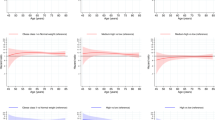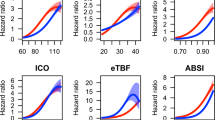Abstract
Objectives
The impact of adiposity on mortality in older adults remains controversial. Some reports suggest that measures of general adiposity such as body mass index (BMI) predict better survival. We assessed the relationship between measures of adiposity and mortality in older adults.
Design
Cross-sectional analysis of a population-based sample.
Setting
Non-institutionalized persons in the United States participating in the National Health and Nutrition Examination Surveys III and its linked mortality dataset.
Participants
A subsample of 4,489 non-institutionalized survey participants aged >60 years with measures of body composition using bioimpedance. To account for possible residual confounding, smokers, subjects with heart failure, respiratory disease, kidney disease and cancer were excluded (n=2,920). Data from 1569 subjects were analysed.
Measurements
BMI, waist circumference (WC), waist-hip ratio (WHR), lean mass (LM) and % Body Fat (BF) were classified by tertiles (lowest=referent). Proportional-hazard models evaluated the association of anthropometric indices with overall and cardiovascular mortality.
Results
Mean age was 69.4years, and 265(16.9%) were >80 years. There were 717(47.6%) women and 792 deaths of which 284 [35.9%] were cardiovascular related. Elevated BMI was associated with reduced cardiovascular mortality (HR 0.53 [0.30–0.84]), and remained significant after adjusting for LM (HR 0.54 [0.31–0.93]). Elevated %BF was associated with reduced mortality from cardiovascular causes (HR 0.52 [0.29–0.91]). Low BMI was associated with higher risk of cardiovascular (HR 3.66 [1.25–10.69]) and overall death (HR 2.44 [1.22–4.90]).
Conclusion
Measures of adiposity in older participants are associated with lower mortality from cardiovascular causes that cannot be explained by major known confounders between obesity and mortality. Further studies need to elucidate a possible protective role and interplay between adiposity and skeletal muscle in older adults.
Similar content being viewed by others
Abbreviations
- BF:
-
body fat
- BMI:
-
body mass index
- CHF:
-
congestive heart failure
- CV:
-
Cardiovascular
- HDL:
-
high density lipoprotein
- LDL:
-
low density lipoprotein
- LM:
-
lean mass
- NHANES:
-
National Health and Nutrition Examination Survey
- WC:
-
waist circumference
- WHR:
-
waist-hip ratio
References
Spillman BC and Lubitz J (2000) The effect of longevity on spending for acute and long-term care. N Engl J Med 342:1409–15. doi: 10.1056/nejm200005113421906
Batsis JA, Nieto-Martinez RE and Lopez-Jimenez F (2007) Metabolic syndrome: from global epidemiology to individualized medicine. Clin Pharmacol Ther 82:509–524. doi: 10.1038/sj.clpt.6100355
Flegal KM, Graubard BI, Williamson DF and Gail MH (2005) Excess deaths associated with underweight, overweight, and obesity. JAMA 293:1861–1867. doi: 10.1001/jama.293.15.1861
Gregg EW, Cheng YJ, Cadwell BL, Imperatore G, Williams DE, Flegal KM, Narayan KM and Williamson DF (2005) Secular trends in cardiovascular disease risk factors according to body mass index in US adults. JAMA 293:1868–1874. doi: 10.1001/jama.293.15. 1868
Chambers BA, Guo SS, Siervogel R, Hall G and Chumlea WC (2002) Cumulative effects of cardiovascular disease risk factors on quality of life. J Nutr Health Aging 6:179–184.
Larrieu S, Peres K, Letenneur L, Berr C, Dartigues JF, Ritchie K, Fevrier B, Alperovitch A and Barberger-Gateau P (2004) Relationship between body mass index and different domains of disability in older persons: the 3C study. Int J Obes Relat Metab Disord 28:1555–1560. doi: 10.1038/sj.ijo.0802755
Zizza CA, Herring A, Stevens J and Popkin BM (2002) Obesity affects nursing-care facility admission among whites but not blacks. Obes Res 10:816–823. doi: 10.1038/oby.2002.110
Wellens RI, Roche AF, Khamis HJ, Jackson AS, Pollock ML and Siervogel RM (1996) Relationships between the Body Mass Index and body composition. Obes Res 4:35–44.
Prospective Studies C, Whitlock G, Lewington S, Sherliker P, Clarke R, Emberson J, Halsey J, Qizilbash N, Collins R and Peto R (2009) Body-mass index and cause-specific mortality in 900 000 adults: collaborative analyses of 57 prospective studies. Lancet 373:1083–1096. doi: 10.1016/s0140-6736(09)60318-4
Flegal KM, Kit BK, Orpana H and Graubard BI (2013) Association of all-cause mortality with overweight and obesity using standard body mass index categories: a systematic review and meta-analysis. JAMA 309:71–82. doi: 10.1001/jama.2012.113905
Flicker L, McCaul KA, Hankey GJ, Jamrozik K, Brown WJ, Byles JE and Almeida OP (2010) Body mass index and survival in men and women aged 70 to 75. J Am Geriatr Soc 58:234–241. doi: 10.1111/j.1532-5415.2009.02677.x
Okorodudu DO, Jumean MF, Montori VM, Romero-Corral A, Somers VK, Erwin PJ and Lopez-Jimenez F (2010) Diagnostic performance of body mass index to identify obesity as defined by body adiposity: a systematic review and meta-analysis. Int J Obes (Lond) 34:791–799. doi: 10.1038/ijo.2010.5
Smalley KJ, Knerr AN, Kendrick ZV, Colliver JA and Owen OE (1990) Reassessment of body mass indices. Am J Clin Nutr 52:405–408.
Onat A, Avci GS, Barlan MM, Uyarel H, Uzunlar B and Sansoy V (2004) Measures of abdominal obesity assessed for visceral adiposity and relation to coronary risk. Int J Obes Relat Metab Disord 28:1018–1025. doi: 10.1038/sj.ijo.0802695
Chumlea WC, Guo SS, Kuczmarski RJ, Flegal KM, Johnson CL, Heymsfield SB, Lukaski HC, Friedl K and Hubbard VS (2002) Body composition estimates from NHANES III bioelectrical impedance data. Int J Obes Relat Metab Disord 26:1596–1609. doi: 10.1038/sj.ijo.0802167
Levey AS, Stevens LA, Schmid CH, Zhang YL, Castro AF, 3rd, Feldman HI, Kusek JW, Eggers P, Van Lente F, Greene T, Coresh J and Ckd EPI (2009) A new equation to estimate glomerular filtration rate. Ann Intern Med 150:604–612.
Flegal KM and Graubard BI (2009) Estimates of excess deaths associated with body mass index and other anthropometric variables. Am J Clin Nutr 89:1213–1219. doi: 10.3945/ajcn.2008.26698
National Vital Statistics Report (2012) National Center for Health Statistics. US Department of Health and Human Services. Centers for Disease Control, Hyattsville, MD.
Bagger YZ, Rasmussen HB, Alexandersen P, Werge T, Christiansen C, Tanko LB and group Ps (2007) Links between cardiovascular disease and osteoporosis in postmenopausal women: serum lipids or atherosclerosis per se? Osteoporos Int 18:505–512. doi: 10.1007/s00198-006-0255-2
Stenholm S, Harris TB, Rantanen T, Visser M, Kritchevsky SB and Ferrucci L (2008) Sarcopenic obesity: definition, cause and consequences. Current Opinion in Clinical Nutrition and Metabolic Care 11:693–700. doi: 10.1097/MCO.0b013e328312c37d
Bostrom P, Wu J, Jedrychowski MP, Korde A, Ye L, Lo JC, Rasbach KA, Bostrom EA, Choi JH, Long JZ, Kajimura S, Zingaretti MC, Vind BF, Tu H, Cinti S, Hojlund K, Gygi SP and Spiegelman BM (2012) A PGC1-alpha-dependent myokine that drives brown-fat-like development of white fat and thermogenesis. Nature 481:463–468. doi: 10.1038/nature10777
Janssen I and Mark AE (2007) Elevated body mass index and mortality risk in the elderly. Obes Rev 8:41–59. doi: 10.1111/j.1467-789X.2006.00248.x
Flegal KM, Shepherd JA, Looker AC, Graubard BI, Borrud LG, Ogden CL, Harris TB, Everhart JE and Schenker N (2009) Comparisons of percentage body fat, body mass index, waist circumference, and waist-stature ratio in adults. Am J Clin Nutr 89:500–508. doi: 10.3945/ajcn.2008.26847
Zamboni M, Mazzali G, Fantin F, Rossi A and Di Francesco V (2008) Sarcopenic obesity: A new category of obesity in the elderly. Nutrition Metabolism and Cardiovascular Diseases 18:388–395. doi: 10.1016/j.numecd.2007.10.002
Allison DB, Heo M, Flanders DW, Faith MS, Carpenter KM and Williamson DF (1999) Simulation study of the effects of excluding early deaths on risk factor-mortality analyses in the presence of confounding due to occult disease: the example of body mass index. Ann Epidemiol 9:132–142.
Kuk JL and Ardern CI (2009) Influence of age on the association between various measures of obesity and all-cause mortality. J Am Geriatr Soc 57:2077–2084. doi: 10.1111/j.1532-5415.2009.02486.x
Manson JE, Bassuk SS, Hu FB, Stampfer MJ, Colditz GA and Willett WC (2007) Estimating the number of deaths due to obesity: can the divergent findings be reconciled? J Womens Health (Larchmt) 16:168–76. doi: 10.1089/jwh.2006.0080
Lavie CJ, Milani RV and Ventura HO (2009) Obesity and cardiovascular disease: risk factor, paradox, and impact of weight loss. J Am Coll Cardiol 53:1925–1932. doi: 10.1016/j.jacc.2008.12.068
Rothman K, Greenland S and Lash T (2008) Modern Epidemiology. Wolters Kluwer/Lippincott Wiliams & Wilkins, Philadelphia, PA, USA.
Flegal KM, Graubard BI, Williamson DF and Cooper RS (2011) Reverse causation and illness-related weight loss in observational studies of body weight and mortality. Am J Epidemiol 173:1–9. doi: 10.1093/aje/kwq341
Zizza C, Herring A, Domino M, Haines P, Stevens J and Popkin BM (2003) The effect of weight change on nursing care facility admission in the NHANES I Epidemiologic Followup Survey. J Clin Epidemiol 56:906–913.
Marini E, Buffa R, Saragat B, Coin A, Toffanello ED, Berton L, Manzato E and Sergi G (2012) The potential of classic and specific bioelectrical impedance vector analysis for the assessment of sarcopenia and sarcopenic obesity. Clin Interv Aging 7:585–591. doi: 10.2147/cia.s38488
Author information
Authors and Affiliations
Corresponding author
Rights and permissions
About this article
Cite this article
Batsis, J.A., Singh, S. & Lopez-Jimenez, F. Anthropometric measurements and survival in older Americans: Results from the third national health and nutrition examination survey. J Nutr Health Aging 18, 123–130 (2014). https://doi.org/10.1007/s12603-013-0366-3
Received:
Accepted:
Published:
Issue Date:
DOI: https://doi.org/10.1007/s12603-013-0366-3




